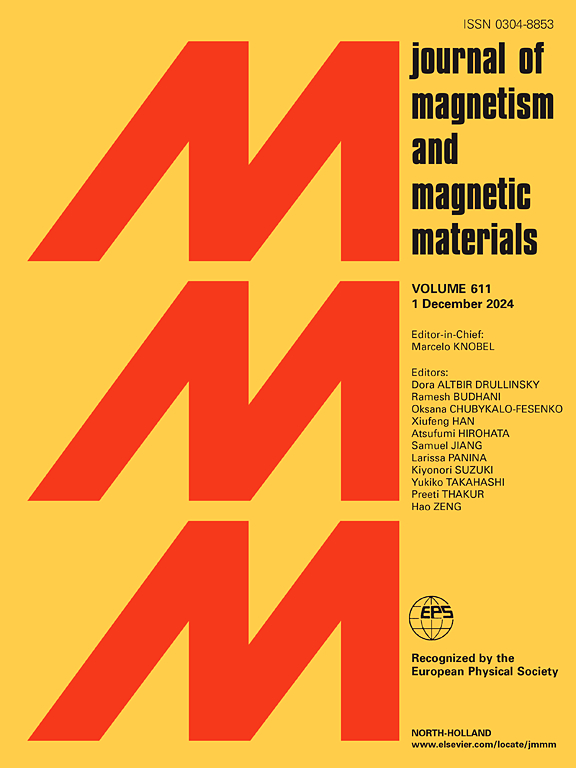Investigations on physicochemical, magnetic and photocatalytic properties of magnetite-rich stones from Palakkad Gap, Western Ghats, India
IF 2.5
3区 材料科学
Q3 MATERIALS SCIENCE, MULTIDISCIPLINARY
引用次数: 0
Abstract
The southern side of Palakkad Gap, a region in the Western Ghats, India, is observed to have an abundance of rocks and stones that exhibit magnetic attraction. This study investigates the physicochemical, photocatalytic, and magnetic properties of the magnetite separated from such stones collected from the Palakkad Gap in an environmentally friendly manner. The collected stones were powdered, and the magnetite was separated using a magnet and purified. Characterization using X-ray diffraction (XRD) confirmed the presence of magnetite, while Thermogravimetric Analysis (TGA) demonstrated its thermal stability at lower temperatures. The Energy Dispersive X-ray (EDX) analysis identified the elements, which included carbon, magnesium, aluminium, silica, potassium, titanium, iron, and cobalt. Following magnetic separation, iron and oxygen were found to be the dominant elements. The magnetite material’s surface morphology and optical characteristics were further examined using Field Emission Scanning Electron Microscopy (FESEM), Photoluminescence (PL), and Ultraviolet–Visible Spectroscopy (UV), with the UV analysis estimating a direct band gap energy of 2.04 eV. Vibrating Sample Magnetometer (VSM) measurements revealed strong ferrimagnetic properties of the magnetite sample. The photocatalytic efficiency of the magnetite was assessed through the degradation of dyes such as Congo red (CR), Methyl orange (MO), and Methylene blue (MB). The results indicate high degradation efficiencies of 96.74 % for MB, 97.21 % for MO, and 98.99 % for CR within 2 h under visible light with excellent recyclability in natural conditions. Furthermore, the possibility of reusing the treated dye solutions was evaluated by conducting Vigna radiata seed germination tests. The tests demonstrated significant seed growth, suggesting the degraded dye solutions were non-toxic and suitable for potential agricultural applications.
印度西高止山帕拉卡德峡谷富磁铁矿的物理化学、磁性和光催化特性研究
在印度西高止山脉的帕拉卡德峡谷南侧,人们观察到有大量的岩石和石头表现出磁性吸引力。本研究以环保的方式研究了从Palakkad峡谷收集的这些石头中分离出的磁铁矿的物理化学、光催化和磁性。收集到的石头被磨成粉末,磁铁矿用磁铁分离提纯。x射线衍射(XRD)表征证实了磁铁矿的存在,热重分析(TGA)证实了其在较低温度下的热稳定性。能量色散x射线(EDX)分析确定了这些元素,包括碳、镁、铝、硅、钾、钛、铁和钴。经过磁分离,发现铁和氧是主要元素。利用场发射扫描电镜(FESEM)、光致发光(PL)和紫外-可见光谱(UV)进一步研究了磁铁矿材料的表面形貌和光学特性,紫外分析估计其直接带隙能为2.04 eV。振动样品磁强计(VSM)测量结果表明,该磁铁矿样品具有强铁磁性。通过对刚果红(CR)、甲基橙(MO)、亚甲基蓝(MB)等染料的降解,评价了该磁铁矿的光催化效率。结果表明,在可见光条件下,2 h内对MB、MO和CR的降解效率分别为96.74%、97.21%和98.99%,在自然条件下具有良好的可回收性。此外,通过进行辐射维纳种子发芽试验,评估了重复使用处理过的染料溶液的可能性。试验表明种子生长显著,表明降解染料溶液无毒,适合潜在的农业应用。
本文章由计算机程序翻译,如有差异,请以英文原文为准。
求助全文
约1分钟内获得全文
求助全文
来源期刊

Journal of Magnetism and Magnetic Materials
物理-材料科学:综合
CiteScore
5.30
自引率
11.10%
发文量
1149
审稿时长
59 days
期刊介绍:
The Journal of Magnetism and Magnetic Materials provides an important forum for the disclosure and discussion of original contributions covering the whole spectrum of topics, from basic magnetism to the technology and applications of magnetic materials. The journal encourages greater interaction between the basic and applied sub-disciplines of magnetism with comprehensive review articles, in addition to full-length contributions. In addition, other categories of contributions are welcome, including Critical Focused issues, Current Perspectives and Outreach to the General Public.
Main Categories:
Full-length articles:
Technically original research documents that report results of value to the communities that comprise the journal audience. The link between chemical, structural and microstructural properties on the one hand and magnetic properties on the other hand are encouraged.
In addition to general topics covering all areas of magnetism and magnetic materials, the full-length articles also include three sub-sections, focusing on Nanomagnetism, Spintronics and Applications.
The sub-section on Nanomagnetism contains articles on magnetic nanoparticles, nanowires, thin films, 2D materials and other nanoscale magnetic materials and their applications.
The sub-section on Spintronics contains articles on magnetoresistance, magnetoimpedance, magneto-optical phenomena, Micro-Electro-Mechanical Systems (MEMS), and other topics related to spin current control and magneto-transport phenomena. The sub-section on Applications display papers that focus on applications of magnetic materials. The applications need to show a connection to magnetism.
Review articles:
Review articles organize, clarify, and summarize existing major works in the areas covered by the Journal and provide comprehensive citations to the full spectrum of relevant literature.
 求助内容:
求助内容: 应助结果提醒方式:
应助结果提醒方式:


